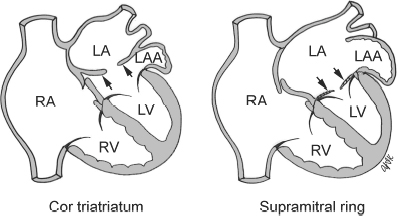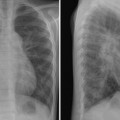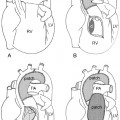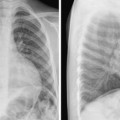20 Abnormalities of the Mitral Valve and Related Anomalies Fig. 20.1 Comparison of cor triatriatum and supramitral stenosing ring. LA, left atrium; LAA, left atrial appendage; LV, left ventricle; RA, right atrium; RV, right ventricle.
Definition and Classification
 Various anatomic lesions result in obstruction to flow from the left atrium to left ventricle.
Various anatomic lesions result in obstruction to flow from the left atrium to left ventricle.
 Congenital mitral stenosis is a malformed valve of variable morphology, including hypoplasia of the annulus, fusion of leaflets, double orifice valve, shortened or thickened chordae tendineae, and abnormal papillary muscles.
Congenital mitral stenosis is a malformed valve of variable morphology, including hypoplasia of the annulus, fusion of leaflets, double orifice valve, shortened or thickened chordae tendineae, and abnormal papillary muscles.
 Cor triatriatum versus supramitral stenosing ring (Fig. 20.1):
Cor triatriatum versus supramitral stenosing ring (Fig. 20.1):
 Shone’s syndrome is the concurrence of both left ventricular inflow and outflow tract obstructions. The left ventricular inflow obstructions include supravalvar mitral ring, mitral arcade, and parachute mitral valve. The left ventricular outflow obstructions include subvalvar stenosis, bicuspid aortic valve, and aortic coarctation.
Shone’s syndrome is the concurrence of both left ventricular inflow and outflow tract obstructions. The left ventricular inflow obstructions include supravalvar mitral ring, mitral arcade, and parachute mitral valve. The left ventricular outflow obstructions include subvalvar stenosis, bicuspid aortic valve, and aortic coarctation.
 Mitral regurgitation can rarely be due to a congenitally dysplastic mitral valve.
Mitral regurgitation can rarely be due to a congenitally dysplastic mitral valve.

Pathophysiology
Stay updated, free articles. Join our Telegram channel

Full access? Get Clinical Tree





